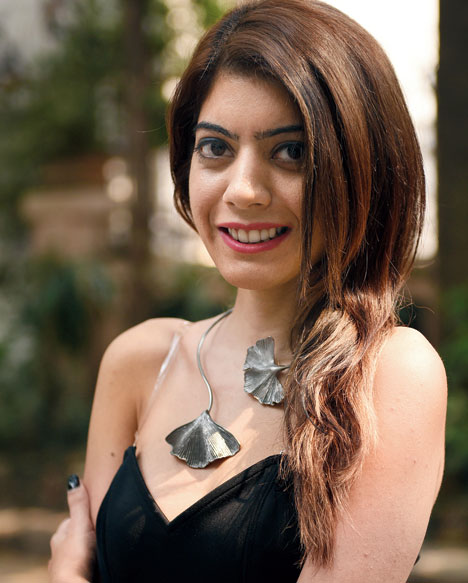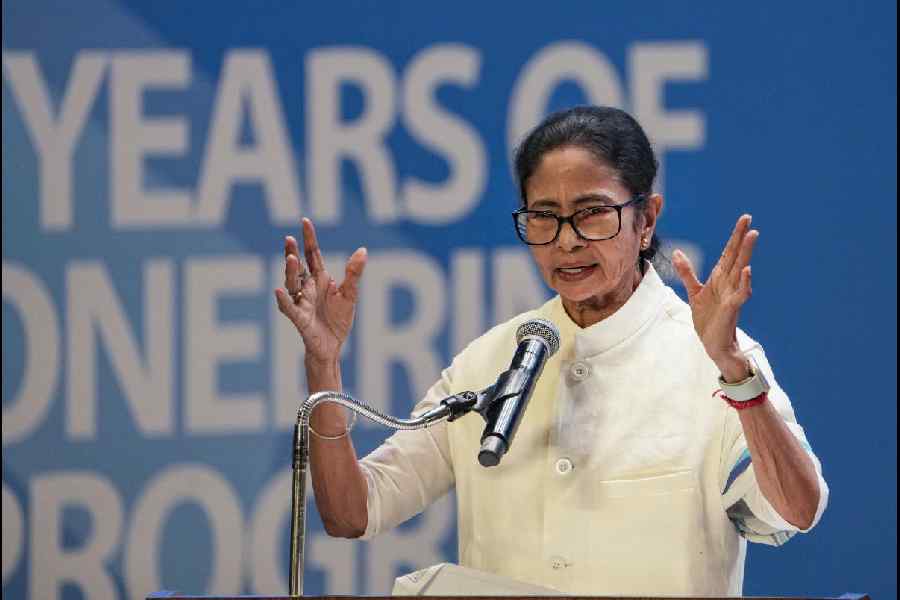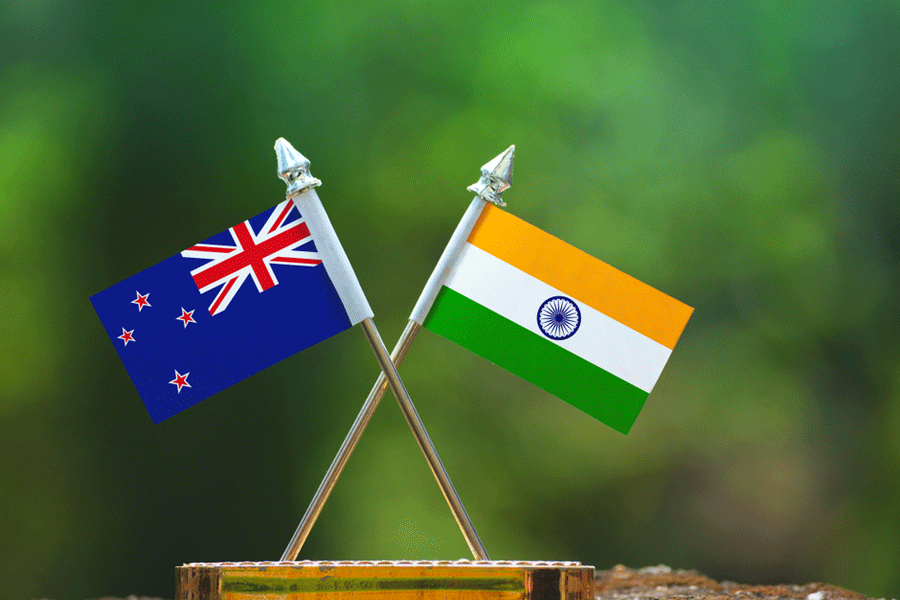When model Ushoshi Sengupta walked in at The Telegraph Food Guide Awards at The Park earlier this month, one of the frequently asked questions was who was she wearing. The answer was Esha Sethi Thirani, a Calcutta girl who is making heads turn with her avant-garde silhouettes, especially with her Paris Fashion Week stint earlier this month. The 32-year-old fashion designer chatted with t2 on her PFW experience and more.

Picture: B. Halder
Stays on: Lord Sinha Road
Cuts her birthday cake on: October 9
Her label is: Five years old
Esha studied: HR at Lancaster University
She launched her first line in: 2013
In Calcutta she retails out of: Advitiya, a multi-designer store at 8C Queens Park, Queens Court, that she co-owns
with her mom Simmi Sethi
Congratulations! What does the Paris Fashion Week experience mean?
Thank you! Well, it is a beginning to taking our label overseas. We wanted to make the point that we will stick to our roots but we will present it in a modern way. The idea was to westernise the silhouettes, which for me is the USP of our brand. We stick to our Indian embroideries, but contemporise it.
In Paris, we were at the InterContinental Paris — Le Grand, which was a beautiful location. These shows were running adjacent to the main shows. We had a lot of attendees who were seeing big designers come and see our work also. We showcased eight pieces. This has given us a new platform.
How did you land the show?
Oxford Fashion Studio — a London-based agency that promotes upcoming talent on these platforms in New York, Milan and Paris — sent us an email in October. They had seen our previous couture line. We had three-four months to prep ourselves. We left in February and we had a four-day showroom prior to the show where we met with buyers. Then the show happened on March 3. It’s an autumn-winter ’18 collection.
Tell us about those butterflies in your stomach!
Of course (there were butterflies)! The fact that we got invited was a big deal! It was exciting and also made us very nervous. We’ve never done a Lakme Fashion Week or an Amazon (Amazon India Fashion Week). In 2015, we did India Beach Fashion Week in Goa where we showcased our resort-wear collection. The jump from India Beach Fashion Week to Paris Fashion Week was of course overwhelming. I think the results have been fantastic. I couldn’t have refused such an opportunity. It was such a boost of morale that we were chosen and we had to show what we were all about. We’ve always wanted to take the label overseas.
.jpg)
You have reinterpreted kalamkari through your collection Qalamkar…
We have toned down a lot of the colours. A lot of the silhouettes are very empowering and black sort of gives it that feel. The starkness of black blended with the earthy tones of kalamkari. Normally when kalamkari is done, the fabric is bleached. We have left it unbleached because we liked the off-white tone.
We have used fabrics which are as different as tulle which is soft, neoprene which is very structured to jute cotton, which is very heavy, to net which is feminine. The juxtaposition and that play of softness and the power of the structure and the architectural feel are basically the essence of the collection. Power dressing is big now. Keeping that power play in mind, we have designed the collection.
We have short dresses, a jumpsuit, trench coat, gown… we have also given the LBD a strong twist… very diverse range of silhouettes. It can be worn by a teenager and also a middle-aged woman. A pleated cape is one of my favourites.
What about the accessories?
Very warrior-like accessories. We again wanted to put forward that power-woman mood. We have used Indian accessories like the maangtika on the warrior head and nath. The embroidery on the boots is again Indian.
What does the brand believe in?
We want to do things that people can wear regularly. Timeless pieces that they won’t get bored of. Our forte has been fusion. The journey has been fantastic. I am totally in love with what I do.
Whose work do you love?
I love Anamika (Khanna) for the fact that she is again very fusion and with her garments, you can play around with it and deconstruct it and wear it. She gave us the dhoti pants which have become such a rage over the years. Her draping, of course! Fantastic. I love Tarun (Tahiliani)… he does simple clothes. I don’t like the idea of looking like a Christmas tree!
Alexander McQueen, internationally. Sarah Burton (creative director) has taken the brand forward flawlessly. Elie Saab is the king of couture gowns, a master of embroidery.
As a young designer, what are the challenges?
Keeping the economics in mind for a young designer is important. You have to be well-priced. The one challenge that I faced… when you start and you are like, ‘I am not going to do this and not going to compromise on my creativity’… my mom keeps telling me that you have to make what people want, otherwise you are not going to sell. That balance has to be maintained. Your best collection may not be the most saleable one.
What are your other passions?
I really hope I can find time for art. I used to paint a lot. That has taken a back seat. There are days when I just want to shut myself in a small room and paint, but I can’t because there’s Namah (her two-year-old daughter) banging on the door or some client calling! (Laughs)
What: Royal Trousseau by Abha Dalmia
Where: 85 Lansdowne, 85B Sarat Bose Road
When: March 27, 11am to 7.30pm

Abha Dalmia endeared us to her the moment she broke into Bengali when t2 dialled her for a chat about her showing at 85 Lansdowne on March 27. “Aami Bangali bhalo bujhtey pari. I am basically half-Bengali in my thoughts,” said the septuagenarian, who called Calcutta home till she got married in 1962. The Prithviraj Road (Delhi) resident is the boss of Abha Dalmia, a brand known for its Benarasi saris.
When did you discover saris?
When I got married… I started practising wearing saris when I got engaged. Every Saturday I used to wear a sari. I am most comfortable in a sari… one looks most graceful in a sari.
What are you getting to 85 Lansdowne?
A collection of saris. I am bringing traditional saris like brocade. I also do a lot of chiffons, but not your regular chiffons. Georgette, katan, silk organza….
What has your 35-year-old journey as a “textile lover” been like?
I love textiles and despite the stress of time, I continued and I have no regrets. Everything is hand-done. I have my team to help me with the technical aspects. The Benaras loom is the most versatile loom.
I took it up as a challenge when some very poor weavers were sent to me, who had nowhere to go… my daughter was getting married and I gave them a couple of my own saris for revival and from there I stayed on. And they wouldn’t sustain only by making my personal collection… they wouldn’t survive…. Mine is a non-commercial venture. I am doing it to revive the old, traditional designs and give work to the weavers and support their family. Whatever I have done, I have done it out of my love for textiles from childhood. I have seen a lot of textile and art from my childhood.
I tried to revive the old designs and I travelled a lot and so got a lot of inputs from, say, Thailand, France, Japan and we did collections inspired by these countries because they are all very good in textiles.
At that time no one was doing a Japanese or a Thai collection. Now, every second person has become a textile designer
or a Benarasi weaver… a lot of these products are not up to the mark. I am very content with the people I reach and that’s why I stick to exhibitions because I want to be on my own. I don’t want to be dictated by the market and I sell on my price. I am doing it just as a hobby.
The revival is also with a modern touch. Nobody used to weave black in Benaras back then. A lot of people laughed at me, but now black Benarasi is selling.

Everyone is into revival these days…
At least they say so, even if they are not doing it! (Laughs) It is a fashion statement… let’s be frank! The best part is that the weavers I worked with, their children prospered.
What is your personal sari collection like?
I have all kinds… Benarasi, Kanjeevaram, Dhakai… I wear a lot of French chiffons.
You keep coming back to Calcutta…
I come to Calcutta all the time. My parents lived on Alipore Road and I was in Calcutta till I got married in 1962. I find Calcutta very pleasing to the heart because I have been brought up there. The warmth in Calcutta is still there. Though it is a major city, there is something very soft and serene there despite all the chaos on the road. You don’t like the look of Calcutta to a certain extent but you like the people of Calcutta.










